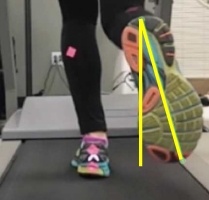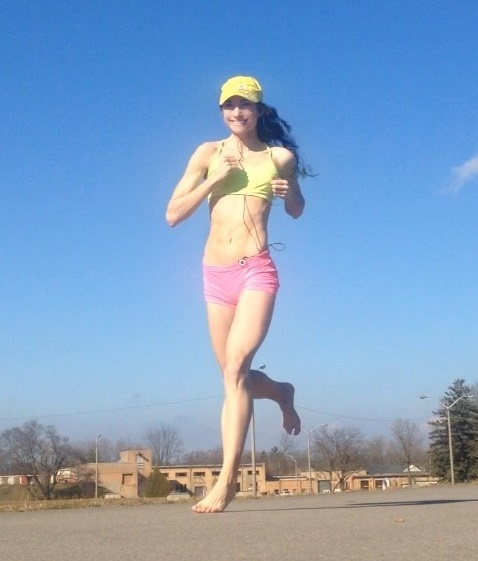There are many ways heel strike running is bad for the Achilles tendon. One sure way is heel strike running causes excessive heel movements that increases loading and bending strain on the Achilles as compared with forefoot running.
It turns out that the heel-to-toe movement path of the foot in heel strike running causes the foot to spend more time on the ground during the stance phase which allows more time for abnormal motions and postures of the heel to take hold, which they do.
In fact, research has found that the increased ground-contact time of the foot in heel strike running causes the heel to rapidly jerk and whip which increases bending and twisting strain on the Achilles tendon.
The raw facts on this came from a 2015 study in the journal Physical Medicine and Rehabilitation found that heel strike runners had a pronounced heel whip angle as follows:
-
- Over half of the runners had a heel whip angle of >5 degrees (a heel whip angle of <5 degrees is considered neutral/normal/unburdening).
-
- The heel whip angle range in the runners was between 29 degrees lateral (heel whipped sideways) and 32 degrees medial (heel whipped towards the mid-line).

This data suggests that, one way or another, the way the mechanical components of heel strike running forces the heel into extreme positions is very damaging to the Achilles tendon, and when your feet are weak, footstep instability is almost certain, which will project even more stress on the tendon!
Related research also found that the heel whip in heel strike running caused medial and lateral rotations of the foot in the transverse plane (side-to-side motions) during the initial swing phase which significantly altered the position of the Achilles, putting additional loading across the tendon.
These findings are directly inline with the scientific and anecdotal data-trend showing that the Achilles tendon is more vulnerable to injury in heel strike running, even with all the advancements in running shoe technology.
Worse still, thick, cushioned heeled running shoes will exacerbate heel whipping even more in heel strike running because these shoes are on record for increasing ground-contact time, forcing the feet into extreme positions AND causes the foot to pound harder into the ground than running barefoot or running in minimalist shoes, which encourages a forefoot strike which in turn naturally accompanies lighter, shorter, safer foot-ground interactions.
-
- One reason thickly cushioned running shoes increases ground-contact time as compared with running in minimalist shoes or running barefoot is because reflexive withdrawal of the foot is slowed thereby causing the foot to linger on the ground longer, leaving more time for abnormal foot movements to occur.
In order to stop the heel from whipping and straining the Achilles tendon when running, land with a forefoot strike! For one, by impact standards, forefoot running is much less forceful on the Achilles tendon because there’s significantly less all-around impact levels loading through the tendon. For another, forefoot running naturally reduces ground-contact time by increasing step-rate which results in a ground-contact time thats so brief, there’s less time for unwanted foot movements to occur. This is how forefoot running provides better protections against bending strain and rotational stress on the Achilles tendon than heel strike running.

Most relevant, running barefoot or in barefoot-like running shoes (minimalist running shoes) not only optimizes your forefoot running form, making you more mechanically adjusted to run safely in shoes, it also makes the foot stronger at holding more firm with the ground, while improving foot shape deformities, such as bunions.
Also, running barefoot ensures minimal ground-contact time by improving the withdrawal reflexes in the leg. This because, when you run barefoot, a range of underfoot sensory nerves are switched on, which activates the withdrawal retraction of the foot at a much higher level, triggering a faster removal of the foot off the ground.
Its for all these reasons that it should be obvious to everyone that foot strike pattern really does matter in running because if you follow the evidence, you’ll find that heel strike running is a very significant producer of a number of risk factors that directly cause injury whereas these risk factors are either eliminated or significantly reduced in forefoot running.
If you’ve enjoyed my blog post on the damaging affects of heel strike running, you’ll love my YouTube channel, here, where I talk in great detail about why forefoot running is the safest and most efficient way to run.
References:
Souza et al. Medial and lateral heel whips: prevalence and characteristics in recreational runners. PM&R, 2015; S1934-1482(15)00116-1.

If you’d like, you can support Run Forefoot and help keep it going by making a donation in any amount of your choosing:

Or, you can also support Run Forefoot by shopping at the following top minimalist shoes brands, and be sure to bookmark the links:
Be Lenka: https://www.dpbolvw.net/click-7600968-14330828
FeelGrounds: https://www.feelgrounds.com/?p=RunForefoot
Xero Shoes: https://xeroshoes.com/go/Run_Forefoot
Iguaneye: https://www.iguaneye.com/?ref=8tfXVc92
Soft Star Shoes: https://shrsl.com/3mp1b
Wilding Shoes: https://bit.ly/3lIygQP
Earth Runners: https://earthrunners.com/?rfsn=6763579.f7f9c9
Vivobarefoot: https://shrsl.com/3kvih
Zappos: https://goo.gl/J1CeAd
Bretta Riches
BSc Neurobiology; MSc Biomechanics candidate, ultra minimalist runner & founder of RunForefoot. I was a heel striker, always injured. I was inspired by the great Tirunesh Dibaba to try forefoot running. Now, I'm injury free. This is why I launched Run Forefoot, to advocate the health & performance benefits of forefoot running and to raise awareness on the dangers of heel striking, because the world needs to know.
Latest posts by Bretta Riches (see all)
- Can You Run In Barefoot Shoes? Yes, But DON’T Heel Strike! - 21/07/2024
- Why Cushioned Running Shoes Are Really Bad for Your Feet - 19/07/2024
- Do Cushioned Running Shoes Cause Injuries? - 17/07/2024

